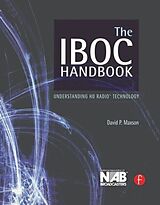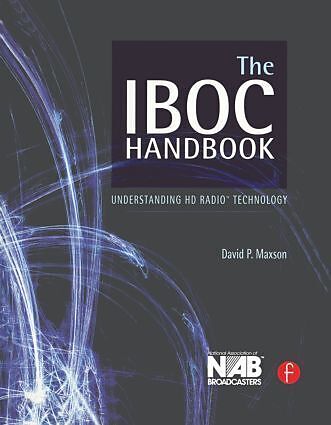The IBOC Handbook
Einband:
Fester Einband
EAN:
9780240808444
Untertitel:
Understanding HD Radio (TM) Technology
Genre:
Elektrotechnik
Autor:
David Maxson
Herausgeber:
Taylor and Francis
Anzahl Seiten:
512
Erscheinungsdatum:
20.06.2007
ISBN:
978-0-240-80844-4
This book explains how IBOC works and how to implement it, and should be on the desk of every radio broadcast engineer and every person who designs or implements IBOC technology.
Informationen zum Autor David Maxson is Managing Partner of Broadcast Signal Lab! LLP! which he co-founded in 1982 to serve the needs of radio and television stations in the northeastern United States. Under his direction! Broadcast Signal Lab provides a full spectrum of technical services related to radio frequency safety! regulatory compliance! compatibility and interference issues. David also consults with emerging wireless and broadcasting technology companies on digital media deployment issues. For twenty years David served Charles River Broadcasting Company! whose flagship station was classical radio WCRB! Boston. As Vice President! Director of Engineering he was responsible for technical and engineering matters for the company's radio stations! its classical music production and syndication company! and its commercial sound system company. David is Broadcast Signal Lab's representative to the National Radio Systems Committee (NRSC) Digital Audio Broadcasting Subcommittee. With the NRSC! he was closely involved with the testing and evaluation of proposed In-Band! On-Channel (IBOC) digital radio broadcasting systems! which ultimately led to a formal IBOC standard in April of 2005. David chaired the NRSC DAB Data Multiplexing and Transport Task Group. He has published and presented numerous technical papers on IBOC signal measurement technique and on data broadcasting technology. Klappentext Intended for radio broadcast engineers seeking to design and operate HD Radio[trademark] transmission systems! this book lays out the structure of this digital transmission system. It also presents a summary of the history of the technology and the NRSC-5 standard. Zusammenfassung This book explains how IBOC works and how to implement it, and should be on the desk of every radio broadcast engineer and every person who designs or implements IBOC technology.
Autorentext
David Maxson is Managing Partner of Broadcast Signal Lab, LLP, which he co-founded in 1982 to serve the needs of radio and television stations in the northeastern United States. Under his direction, Broadcast Signal Lab provides a full spectrum of technical services related to radio frequency safety, regulatory compliance, compatibility and interference issues. David also consults with emerging wireless and broadcasting technology companies on digital media deployment issues. For twenty years David served Charles River Broadcasting Company, whose flagship station was classical radio WCRB, Boston. As Vice President, Director of Engineering he was responsible for technical and engineering matters for the company's radio stations, its classical music production and syndication company, and its commercial sound system company. David is Broadcast Signal Lab's representative to the National Radio Systems Committee (NRSC) Digital Audio Broadcasting Subcommittee. With the NRSC, he was closely involved with the testing and evaluation of proposed In-Band, On-Channel (IBOC) digital radio broadcasting systems, which ultimately led to a formal IBOC standard in April of 2005. David chaired the NRSC DAB Data Multiplexing and Transport Task Group. He has published and presented numerous technical papers on IBOC signal measurement technique and on data broadcasting technology.
Klappentext
Intended for radio broadcast engineers seeking to design and operate HD Radio[trademark] transmission systems, this book lays out the structure of this digital transmission system. It also presents a summary of the history of the technology and the NRSC-5 standard.
Inhalt
1. Preface 2. Table of Contents 3. Introduction SECTION 1- BACKGROUND 4. State of the IBOC Industry 4.1. Brief history of digital radio broadcasting 4.1.1. Other technologies 4.1.1.1. DAB 4.1.1.2. ISDB 4.1.1.3. DRM 4.1.1.4. Satellite radio 4.1.1.4.1. Terrestrial repeaters 4.1.2. The rise of IBOC 4.1.2.1. Garage science- early 1990?s 4.1.2.2. competitive environment 4.1.2.2.1. The drive to create an in-band solution 4.1.2.2.2. 1995 tests- DABJPL/VOA/ATT-Amati/USADR, etc- discuss only as a milestone in USA IBOC evolution- not system details. 4.1.2.3. USADR gets serious, 1995 4.1.2.4. NRSC DAB subcommittee reconvenes 4.1.2.5. Test & Evaluation process 4.1.2.5.1. Goal: Is IBOC better than analog? 4.1.3. The NRSC-5 Standard 4.1.3.1. Initiation 4.1.3.2. Bumps in the Road 4.1.3.2.1. Codec 4.1.3.3. World of possibilities 4.1.3.3.1. Advanced Data Services 4.1.3.3.2. RDS alignment 4.1.3.3.3. Surround sound 4.1.3.3.4. Multicasting 4.1.4. What is HD Radio? 4.1.5. Regulatory status 4.1.5.1. FCC Rulemaking 4.1.5.2. (Be careful to avoid soon-to-change information) 4.2. Station Deployments 4.2.1. Statistics 4.2.1.1. annual progression? 4.2.2. Market Analysis 4.2.2.1. Who is deploying? 4.2.2.2. What is being deployed most? 4.2.3. Receiver penetration 4.3. IBOC Economics 4.3.1. HD Radio Licensing 4.3.1.1. Broadcasters- various fee and feature levels, timing 4.3.1.2. Manufacturers 4.3.2. Conversion costs 4.3.3. Receiver price curve? (cost versus market penetration) 5. How IBOC was approved 5.1. NRSC test and evaluation process 5.1.1. Performance criteria 5.1.1.1. audio quality 5.1.1.2. compatibility with analog receivers 5.1.1.3. extensibility 5.1.1.4. data capability 5.1.1.5. etc.- (take from NRSC eval document) 5.1.1.6. coverage 5.1.1.7. acquisition time 5.1.2. Independent and audited testing to NRSC specifications 5.1.2.1. Only core modes 5.1.2.2. ATSC, lab/iBiquity, field 5.1.2.2.1. Objective testing 5.1.2.2.2. Subjective testing- explain ACR MOS 5.1.2.3. Locations and conditions 5.1.2.4. Audio 5.1.2.4.1. How the changing codecs were handled 5.1.2.5. Analog compatibility 5.1.2.6. Coverage 5.1.3. overall better than analog? 6. Overview of NRSC-5 6.1. Standard 6.2. Reference Documents 6.3. Hybrid vs extended hybrid vs all-digital 6.4. AM 6.5. FM 6.6. Common References 6.7. Data 6.8. The protocol stack, an overview SECTION 2- THE PROTOCOL STACK 7. From the top down: The HDC Audio Codec 7.1. How a codec works 7.2. Evolution of HDC 7.3. Layering 7.3.1. AM hybrid 7.3.2. FM all digital 7.4. Embedded program-associated text 7.4.1. MPSD, SPSD 7.4.2. ID3 basis 7.4.3. fields available, extensibility? 7.4.4. display issues 7.4.5. number of characters 7.4.6. scrolling, truncating, paging (right name on the last one?) 7.5. Other codecs? 8. From the top down: Source Multiplexing (?Layer 2?) 8.1. Bringing audio and data together on the channel (N.B. Many of these subsections are only publishable if the data protocol becomes public domain or iBiquity gives permission by October manuscript date) 8.1.1. Opportunistic data 8.1.2. fixed data 8.1.3. packetization variations- 8.1.3.1. ports and protocols- 8.1.3.2. data as a stream- 8.1.3.3. extra interleaving and FEC for data 8.2. Bandwidth allocation 9. From the top down: Channel Multiplexing and Transmission (?Layer 1?) 9.1. The frame 9.1.1. Purpose of a frame 9.1.2. Reasons for the frame length 9.1.3. Latency 9.2. Logical Channels 9.2.1. Station Modes 9.2.2. PIDS/SIDS 9.2.3. P1-P3 9.3. Packing the frame? how, what and why 9.3.1. Scrambling 9.3.2. Channel encoding 9.3.3. Interleaving 9.4. Carrier Mapping 10. From the top down: The physical layer- OFDM 10.1. OFDM principles 10.1.1. The role of FFT in OFDM 10.2. How OFDM is used for AM and FM band IBOC 10.3. AM OFDM carriers, groupings, power and mask 10.4. FM OFDM carriers, groupings, power and mask 11. Other input: the data services structure 11.1. protocols 11.2. organizing data for transmission 11.3. Data services 11.3.1. Bandwidth demands 11.3.2. Impulse Radio model- data as an internet pipe 11.3.3. subcarrier model- data as a leased private pip

Leider konnten wir für diesen Artikel keine Preise ermitteln ...
billigbuch.ch sucht jetzt für Sie die besten Angebote ...
Die aktuellen Verkaufspreise von 6 Onlineshops werden in Realtime abgefragt.
Sie können das gewünschte Produkt anschliessend direkt beim Anbieter Ihrer Wahl bestellen.
Loading...
Die aktuellen Verkaufspreise von 6 Onlineshops werden in Realtime abgefragt.
Sie können das gewünschte Produkt anschliessend direkt beim Anbieter Ihrer Wahl bestellen.
| # | Onlineshop | Preis CHF | Versand CHF | Total CHF | ||
|---|---|---|---|---|---|---|
| 1 | Seller | 0.00 | 0.00 | 0.00 |
